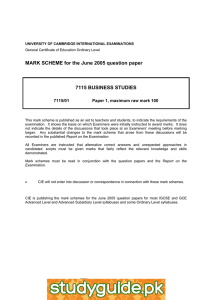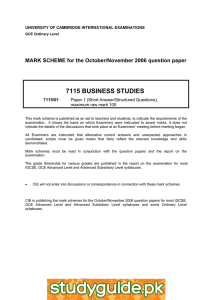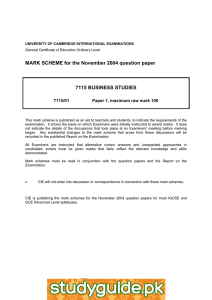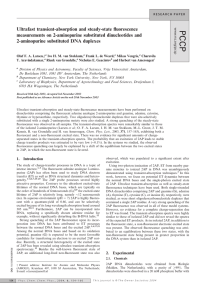MARK SCHEME for the June 2005 question paper 7115 BUSINESS STUDIES www.XtremePapers.com
advertisement
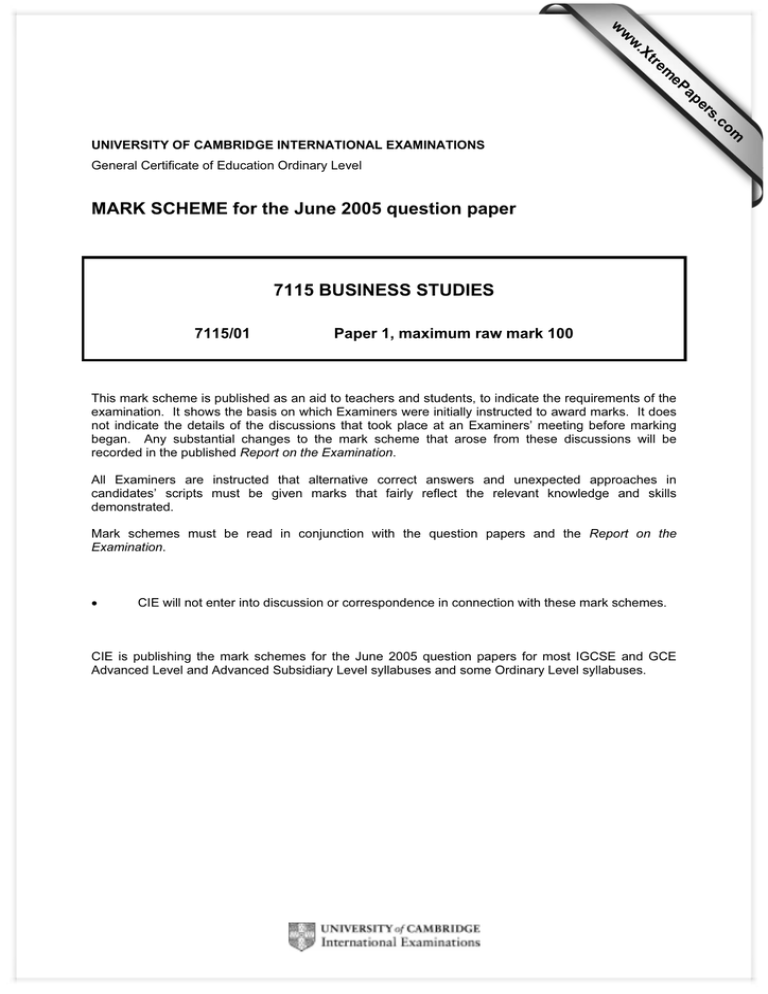
w w ap eP m e tr .X w General Certificate of Education Ordinary Level MARK SCHEME for the June 2005 question paper 7115 BUSINESS STUDIES 7115/01 Paper 1, maximum raw mark 100 This mark scheme is published as an aid to teachers and students, to indicate the requirements of the examination. It shows the basis on which Examiners were initially instructed to award marks. It does not indicate the details of the discussions that took place at an Examiners’ meeting before marking began. Any substantial changes to the mark scheme that arose from these discussions will be recorded in the published Report on the Examination. All Examiners are instructed that alternative correct answers and unexpected approaches in candidates’ scripts must be given marks that fairly reflect the relevant knowledge and skills demonstrated. Mark schemes must be read in conjunction with the question papers and the Report on the Examination. • CIE will not enter into discussion or correspondence in connection with these mark schemes. CIE is publishing the mark schemes for the June 2005 question papers for most IGCSE and GCE Advanced Level and Advanced Subsidiary Level syllabuses and some Ordinary Level syllabuses. om .c s er UNIVERSITY OF CAMBRIDGE INTERNATIONAL EXAMINATIONS June 2005 GCE O LEVEL MARK SCHEME MAXIMUM MARK: 100 SYLLABUS/COMPONENT: 7115/01 BUSINESS STUDIES Paper 1 Page 1 Mark Scheme GCE O LEVEL – June 2005 Syllabus 7115 Paper 1 The scheme indicates how marks are awarded as well as indicating what assessment skills are being tested. k u ap an e 1 = knowledge = understanding = application = analysis = evaluation (a) (i) A fixed cost is a cost that is unrelated to output [1k plus 1u]. Simple response such as does not vary [1]. An acceptable example of a fixed cost [1]. [2] (ii) $16 000 [1u]. $ sign not needed. [1] (iii) $48 000/10 000 [1] = $4.8 [2an] [2] (iv) unit cost = $6.4 [1] plus 50% = $3.2 [1] = $9.6 [1] [1k/1u/1a]. If $4.8 plus 50% = $7.2 [2] i.e. 50% mark up on direct cost per unit not full cost per unit. 1 mark for correct method but numerical errors. [3] (b) Method used is full cost mark up. This ensures that all costs are covered and thus profit is made on what is sold. However fails to consider competitors prices or market conditions. Thus unlikely to be the best [2k + 2ap + 2e]. Identifies method [1 – 2] Analyses method [1 – 2] Evaluates method [1 – 2] (c) 2 [6] If machinery is old then probably less efficient than new machines. Furthermore probably carries higher repair and maintenance costs. [2] marks for identification of advantages [k]/[2] marks for [an]/[2] marks for [ap]. [6] (a) (i) 1.5m [2] i.e. 10% of 15m [1] [k/ap] m needed for full marks. (ii) $540m [2] i.e. 30% of $1800m [1] [k/ap] m needed for full marks but not $. (b) [2] Employees might be misleading because they are only one resource input/capital intensive business replaces people by machines/productivity could rise and hence less labour needed but business has not been reduced in size. [1k/1ap/2e] identification of method [1] explanation/analysis of method evaluation of method [1-2] (c) [2] [1] [4] 3 marks per idea explained. 1 mark per idea identified. Objectives might be to create jobs/improve access of service/improve quality of service/increase affordability of service [2k/4an]. [6] © University of Cambridge International Examinations 2005 Page 2 (d) Mark Scheme GCE O LEVEL – June 2005 Syllabus 7115 Paper 1 Business activity can harm the environment because pollution/noise/visual/atmospheric/negative externalities. But can have a positive impact – beautifying/enhancing. Thus impact is not always damaging [2k/2ap/2e]. identification of impact analysis of impact evaluation of impact [1-2] [1-2] [1-2] [6] Conclusions should be drawn showing evaluation of issues. Evaluative comments must show reasoned judgement. Some consideration is always needed for full marks. 3 (a) (i) Current asset is an asset that can be turned into cash quickly and with certainty [2]. Simple answer such as ready cash [1] [k/u]. [2] (ii) 1.5 [2] ca/cl [1] [1k/1ap] 3: 2 [1]. [2] (b) (i) Identify [2] explain [2]. Sources retained profit/sale of assets/better cash flow management [2k/2ap]. [4] (ii) Use of figures to arrive at conclusion [3]. General discussion [2/1]. No because 78.5% of capital already comes from debt. Thus further debt undesirable/cost of borrowing/impact on profits [2an/1/ap/2e]. general discussion [1-2] use of data and contextual analysis [1-3] [5] (c) (i) 14.3% [3]. 1 for method [1k/2ap] or for inaccurate answer e.g. 14%. The % sign must be included to gain full marks. [3] (ii) Cash and profit not the same. Cash represents available funds. Profit is an accounting surplus. A profit might be declared but debtors are outstanding. Furthermore purchase of assets might lead to cash shortages not matched by any corresponding P/L item [2k/2an]. reason it occurs [why] [1] showing how it creates the difference [1–3] 4 (a) 1 mark per point identified [3] plus further mark for explanation [3] access to larger markets/image boosted/size/features/cost effective [3k/3ap]. awareness of opportunities [1-3] explanation of opportunities [1-3] (b) [4] [6] Technology creates opportunities e.g. cost savings/new methods/new products/new markets. It has also created problems e.g. training/cost/breakdowns [2k/2an/2e]. identification of benefits/disadvantages [1-2] analysis of points made [1-2] evaluative comments showing judgement [1-2] © University of Cambridge International Examinations 2005 [6] Page 3 Mark Scheme GCE O LEVEL – June 2005 Syllabus 7115 Paper 1 (c) (i) Structure is an indication of the relationships between employees in an organisation often showing hierarchy and areas of responsibility. Reference to things like functional areas also acceptable. Simple answer such as shows way the business is organised [1] [1k/1u]. [2] (ii) Span of control refers to the number of subordinates directly accountable to an individual [1k/1u]. To gain full marks reference to Fig. 2 necessary. [2] (iii) Problems of a narrow span of control are over supervision/lack of delegation/top heavy business/costly [2k/2an]. identification of problems [1-2] analysis of problems [1-2] 5 [4] (a) (i) Downswing in level of economic activity [2k]. Limited appreciation such as a fall in an economy [1][1k]. [2] (ii) Recession implies less economic activity and probably falling profits. Thus fewer businesses investing money/thus less demand for computers [4/3]. Ideas but not well linked [2/1] [2an/2ap]. identification of recession and sales [1-2] application in context [1-2] (b) [4] Identify [3] explain [3]. Entry barriers/no demand/unknown in market/local competition/distribution chain/agents lacking/exchange rate movements [3k/3an]. For reason to be accepted it must have direct relevance to the process of exporting. identification of problems [1-3] explanation of problems [1-3] [6] (c) (i) Sales on y axis: time on x axis [1]. Stages are launch/growth/maturity/decline [2]. Alternative terms such as saturation also acceptable [3k]. [3] (ii) Disadvantages of a short product life cycle are that cash inflows are brief/new product innovation is constantly necessary/if sales are not rapid break even may not be reached/left with outdated stock [3an/2ap]. identification of disadvantages [1-3] explanation of disadvantages [1-2] © University of Cambridge International Examinations 2005 [5]
